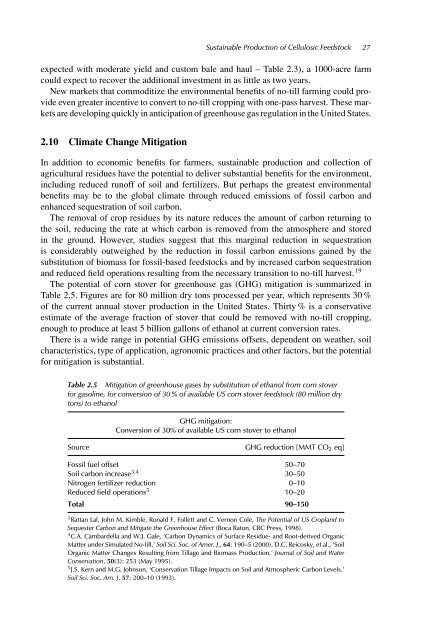Biofuels in Perspective
Biofuels in Perspective
Biofuels in Perspective
You also want an ePaper? Increase the reach of your titles
YUMPU automatically turns print PDFs into web optimized ePapers that Google loves.
Susta<strong>in</strong>able Production of Cellulosic Feedstock 27<br />
expected with moderate yield and custom bale and haul – Table 2.3), a 1000-acre farm<br />
could expect to recover the additional <strong>in</strong>vestment <strong>in</strong> as little as two years.<br />
New markets that commoditize the environmental benefits of no-till farm<strong>in</strong>g could provide<br />
even greater <strong>in</strong>centive to convert to no-till cropp<strong>in</strong>g with one-pass harvest. These markets<br />
are develop<strong>in</strong>g quickly <strong>in</strong> anticipation of greenhouse gas regulation <strong>in</strong> the United States.<br />
2.10 Climate Change Mitigation<br />
In addition to economic benefits for farmers, susta<strong>in</strong>able production and collection of<br />
agricultural residues have the potential to deliver substantial benefits for the environment,<br />
<strong>in</strong>clud<strong>in</strong>g reduced runoff of soil and fertilizers. But perhaps the greatest environmental<br />
benefits may be to the global climate through reduced emissions of fossil carbon and<br />
enhanced sequestration of soil carbon.<br />
The removal of crop residues by its nature reduces the amount of carbon return<strong>in</strong>g to<br />
the soil, reduc<strong>in</strong>g the rate at which carbon is removed from the atmosphere and stored<br />
<strong>in</strong> the ground. However, studies suggest that this marg<strong>in</strong>al reduction <strong>in</strong> sequestration<br />
is considerably outweighed by the reduction <strong>in</strong> fossil carbon emissions ga<strong>in</strong>ed by the<br />
substitution of biomass for fossil-based feedstocks and by <strong>in</strong>creased carbon sequestration<br />
and reduced field operations result<strong>in</strong>g from the necessary transition to no-till harvest. 19<br />
The potential of corn stover for greenhouse gas (GHG) mitigation is summarized <strong>in</strong><br />
Table 2.5. Figures are for 80 million dry tons processed per year, which represents 30 %<br />
of the current annual stover production <strong>in</strong> the United States. Thirty % is a conservative<br />
estimate of the average fraction of stover that could be removed with no-till cropp<strong>in</strong>g,<br />
enough to produce at least 5 billion gallons of ethanol at current conversion rates.<br />
There is a wide range <strong>in</strong> potential GHG emissions offsets, dependent on weather, soil<br />
characteristics, type of application, agronomic practices and other factors, but the potential<br />
for mitigation is substantial.<br />
Table 2.5 Mitigation of greenhouse gases by substitution of ethanol from corn stover<br />
for gasol<strong>in</strong>e, for conversion of 30 % of available US corn stover feedstock (80 million dry<br />
tons) to ethanol<br />
GHG mitigation:<br />
Conversion of 30% of available US corn stover to ethanol<br />
Source GHG reduction [MMT CO2 eq]<br />
Fossil fuel offset 50–70<br />
Soil carbon <strong>in</strong>crease3,4 30–50<br />
Nitrogen fertilizer reduction 0–10<br />
Reduced field operations5 10–20<br />
Total 90–150<br />
3Rattan Lal, John M. Kimble, Ronald F. Follett and C. Vernon Cole, The Potential of US Cropland to<br />
Sequester Carbon and Mitigate the Greenhouse Effect (Boca Raton, CRC Press, 1998).<br />
4C.A. Cambardella and W.J. Gale, ‘Carbon Dynamics of Surface Residue- and Root-derived Organic<br />
Matter under Simulated No-till.’ Soil Sci. Soc. of Amer. J., 64: 190–5 (2000). D.C. Reicosky, et al., ‘Soil<br />
Organic Matter Changes Result<strong>in</strong>g from Tillage and Biomass Production.’ Journal of Soil and Water<br />
Conservation, 50(3): 253 (May 1995).<br />
5J.S. Kern and M.G. Johnson, ‘Conservation Tillage Impacts on Soil and Atmospheric Carbon Levels.’<br />
Soil Sci. Soc. Am. J. 57: 200–10 (1993).








